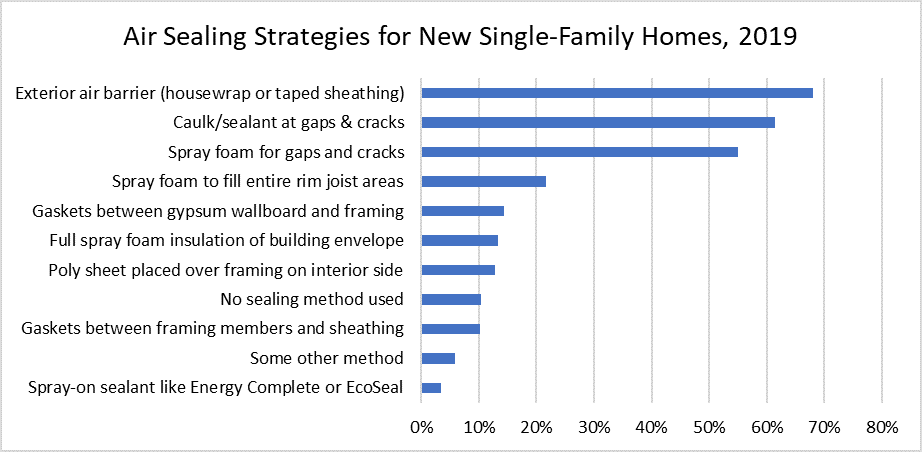

With most of the 2020 Builder Practices Reports now available, we’ve been anxiously reviewing each report for new trends in building products for new homes. In addition to our traditional line up of questions, the 2020 survey contained some new topics—for example, we added questions on air sealing methods for new homes.
According to this year’s survey, 90% of builders incorporated at least one practice to make their homes airtight. The majority of builders use multiple methods—an average of three per home. The most popular approach is making the exterior surface of the building envelope airtight, such as by using housewrap on walls or taping sheathing seams. Close behind was sealing gaps in the envelope with either caulk or spray foam. Some builders said they fill the rim joist bays completely with foam insulation; others said they use spray foam as their primary cavity insulation as part of their airtightness strategies.

Source: Home Innovation Research Labs' Annual Builder Practices Survey
Surprisingly, a full 10% of builders reported no specific method for sealing the envelope—relying solely on structural elements, sheathing, interior wallboard, and insulation to do the job. Another of the more surprising findings from this study was how widely sealing strategies varied by geographic area. For example, housewrap or taped wall sheathing seams were used to seal 80% of homes in the Mid-Atlantic states but only about 20% of homes in the desert Southwest. Gaskets for interior gypsum board, such as with the airtight drywall approach, were used in in about a quarter of homes built in the West but by less than 5% in the Midwest. This practice also varied widely by size of builder—large builders were three times more likely to use wallboard gasketing than small builders.
This is just a glimpse of the findings from our 2020 Builder Practices Survey. Top building product manufacturers have used Home Innovation's survey data for over 25 years to determine market demand and identify trends like these in the building materials market. 2020 Builder Practices Reports will be available in the coming weeks. Contact us now to be among the first to explore your specific product categories in this quickly-evolving market.
The Builder Practices Reports cover building products installed on new homes and can be paired with our annual Consumer Practices Reports to give you a complete view of the residential building materials market. Builder Practices Reports span the following categories:
Appliances | Attic Access | Bathroom Accessories & Shower Doors
Beams | Cabinets for Kitchen & Bath | Cement Usage | Countertops
Deck & Porch Railings | Driveways | Ducts | Exterior Doors | Faucets
Fences & Landscape Walls | Finish Flooring | Fire Sprinkler Systems
Foundations | Garage Doors | Headers | Home Electronics
Home Mechanical Ventilation | Home Standby Generators
House Wrap & Radiant Barriers | HVAC Systems | Insulation
Infrastructure | Insulation | Interior Doors | Interior Finish Materials
Lighting | New Housing Characteristics | Outdoor Structures
Patio Doors | Plumbing Fixtures | Plumbing Piping
Radiant Floor Heating | Roofing | Roofing Underlayment
Sheathing - Floor | Sheathing - Roofs | Sheathing - Walls
Siding or Exterior Finish | Soffit, Fascia & Exterior Trim
Structural Systems - Floor | Structural Systems - Roofs
Structural Systems - Walls | Swimming Pools | Underlayment
Vapor Retarders in Walls & Ceilings | Windows
We also provide more options now in data format than we ever have before. The large survey sample size allows data subscribers to get a very granular look into county, metro area, state, and regional markets for new construction. This year, Builder Practices Reports are available in both tabular and database formats that give you more analysis options, including analysis via business analytics and mapping software like Power BI and Tableau.
Interested in getting the details on your product categories? Get in touch to learn more about how you can better monitor the market for construction products with this report series.
***